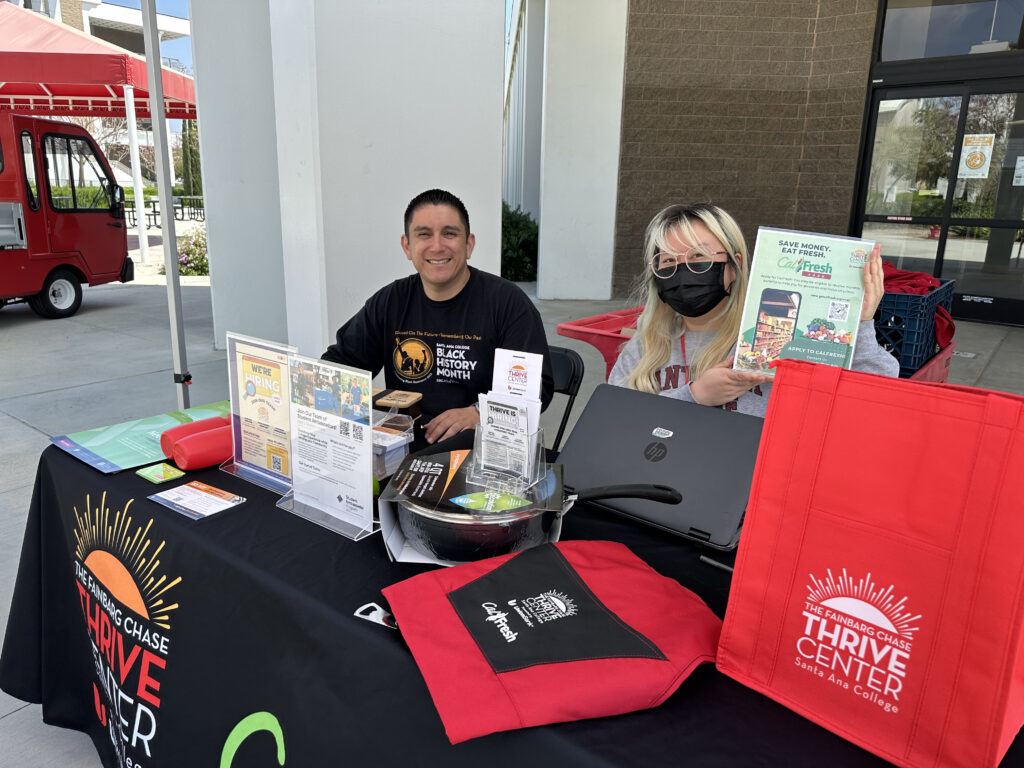
Xavier Navarro, left, was a student ambassador while attending Santa Ana College. In this photo, he was tabling with his adviser, Hope Nguyen.
Over 50 community college students in California currently serve as resource guides for peers in need of stable housing, food access and other basic needs.
The students are part of the California Community Colleges’ Student Ambassador Program, which trains students to share information on available resources, including CalFresh and housing stipends with their fellow students. The program uses peers to share such resources in an effort to reduce the stigma around accessing basic needs services.
“They’re students on the campus, on the ground floor, knowing what students need, knowing how their campus operates, what works, what doesn’t,” said Yuriko Curiel, an ambassador program specialist.
The need is acute. According to a recent report by The Community College League of California and the RP Group, only 32% of the 66,741 students who responded to their survey felt secure in meeting all their basic needs. Over half of respondents were concerned about running out of food; 3 out of 5 students experienced housing insecurity, and 1 in 4 reported experiencing homelessness.
Anecdotes from two recent student ambassadors, Adela Gonzales and Xavier Navarro, highlighted the program’s impact.
Gonzales said in a recent interview that she spoke with a student who was on his way to a Riverside City College parking structure where other students had died by suicide. The student told her that he was heading there because he was contemplating doing the same. But on that day, he came across Gonzales, who was handing out pamphlets regarding various student services, including mental health support.

“I was able to talk with him … give him a little bit of validation, and then walk him to the Student Health and Psychological Center,” said Gonzales, who is studying biochemistry and sociology. “I still message him here and there to see how he’s doing.”
She said what most stood out in her work as an ambassador was how only a few students were aware of the campus’ psychology center or their crisis text hotline. Her interest in supporting other students prompted her to join the program two school years in a row.
At Santa Ana College, Navarro was working at the campus food pantry when he met a fellow student veteran, named Louie, who didn’t have a home.
Meeting Navarro, who was a student ambassador at the time, led to Louie being quickly connected to resources, including a housing voucher to book a hotel room for about a month, food assistance via CalFresh, a free bus pass, and a job at the same food pantry where he met Navarro.
“He was hurting, and it hurts you as a person because you want to help … and now that you have the tools, why not?” said Navarro, who is now an accounting student at Cal Poly Pomona University in Southern California.
It was Navarro’s own experience as a veteran that helped facilitate the initial conversation with Louie.
“We care about the students, we want the students to succeed,” Navarro said. “Because college is hard, it’s expensive, and it can be challenging. Not having a home, not having food. … Caring goes a long way, especially for a college student.”
Students’ identities are crucial in connecting with their peers, said Curiel, the program specialist who was an ambassador before she graduated from San Bernardino Valley College.

“Not only are they connecting with peers, they’re connecting with people who reflect their own community,” she said, noting that Navarro is a veteran; Gonzales, a former foster youth; Curiel was balancing work and school as a single mom during her time as an ambassador.
Ambassadors also often understand being food or housing insecure. Gonzales and Navarro, for example, both relied on CalFresh in the past. Gonzales also received a housing grant while enrolled in college because she couldn’t afford her rent after a roommate moved out of their shared apartment.
Gonzales and Navarro said that a common response they got from students was disbelief that they might qualify for CalFresh, the state’s food assistance program. Complex eligibility rules for students is a known barrier to the program.
“Not everybody on campus knows what’s available to them and how they can access, and even when they access that, there are still questions,” Gonzales said. “Being able to point them in the right direction and get the right information for them is very important.”
The ambassador program was launched in 2016. Students who join are expected to put in at least six to eight hours each month, for which they receive a stipend of $1,500 after completing the program.
The first cohort in 2016 included 20 students, while the current group includes 53 students. Previous groups have included over 100 ambassadors, according to Sarah London, external and executive communications director with the Foundation for California Community Colleges, which operates the program.
“The fluctuation in numbers is solely based on available funding,” said London. “Ideally, we’d have hundreds of ambassadors every year, so we strive to bring on more philanthropic funders to support and help us grow these efforts in the future.”
While student support services vary at the state’s 116 community colleges, some examples include CalFresh application assistance, low-cost auto insurance, a mental health crisis text hotline, and emergency financial aid grants, among others.
Students interested in joining the program must apply for a position and meet eligibility requirements, which include being at least 18 years old, enrolled in at least one unit for the fall and spring semesters during the school year in which they’re applying, and availability to attend a Zoom training.
Gonzales, Navarro and Curiel were all encouraged to apply for the program by staff members managing student organizations they had joined.
For example, Gonzales was part of Guardian Scholars, a chapter-based organization on college campuses that helps support former foster and homeless youth, before learning about the ambassadors program. A staff member with the group noticed that Gonzales often took the initiative by sharing basic needs information with her peers and suggested she apply to be an ambassador.
“I’ve always enjoyed providing resources for all my foster sisters,” she said, adding that joining the ambassador program felt like an extension of what she was already inclined to do in her personal life.
Student ambassadors use a variety of strategies to reach their peers, such as tabling during campus events, creating social media posts, sending out mass emails about available resources, and presenting to their classmates during class breaks.
“This is really investing in our next generation of leaders,” Curiel said. “I see our dean of student services coming out of this, our basic needs coordinators, or people doing public policy; I think that’s just the power of the program.”


